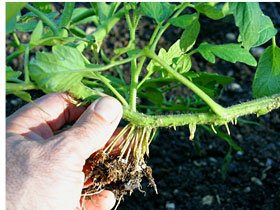

By the end of summer, our tomato patch is usually pretty ragged-looking due to t he ravages of insects, mites, and diseases. It's also stopped setting fruit due to the heat of summer. However, fall is coming and with it comes a fresh new start on the vegetable garden.
New tomato transplants are often difficult to find in July and August but there's no need to go out shopping for new ones. You can revive your old patch for fall tomato rerun. There are two basic ways to do this.
 Rejuvenating Tired Tomatoes
The first method is to cut back the old plants to force them to resprout and
thus regrow a new set of vines for fall. This can be a bit tricky, and I've
killed vines by cutting them back too far in the blazing heat. The plants need
to be well watered and not too stressed, and you'll want to allow some green
growth to remain after cutting them back.
Rejuvenating Tired Tomatoes
The first method is to cut back the old plants to force them to resprout and
thus regrow a new set of vines for fall. This can be a bit tricky, and I've
killed vines by cutting them back too far in the blazing heat. The plants need
to be well watered and not too stressed, and you'll want to allow some green
growth to remain after cutting them back.
My preferred method of reviving an old tomato patch is by tip layering the old plants. Take a long section of vine that can reach all the way to the ground. Remove the leaves from the last foot or so except for a half dozen leaves on the very end of the vine. Use a shovel to scoop out a little hole in the ground where you want the new vine to grow, usually in between two older plants. It doesn't have to be very deep, just a few inches is enough.
Lay the end of the vine in the hole, leaving the tip with leaves to stick up out of the hole. Then fill the hole with soil and water it in well. Continue to water as needed to keep that spot moist. Tomatoes love to root along the vine and within a couple of weeks you'll see roots starting to grow into the ground. After about three weeks this new daughter plant will be ready to take off on its own.
At that point you just cut its connection to the mother plant, and your new star will be ready to go for fall. Then remove the mother plant along with all its mites and diseased leaves. Be aware that there will be plenty of mites and other pests ready to focus their hungry attention on the small, new tomato plants, so take care to protect them with sprays of insecticidal soap or a blast of water directed upward from beneath the foliage.


 "Beautifully illustrated and practical Are you ready to take your garden from good to great?
Learn how to build your soil...and more!
"Beautifully illustrated and practical Are you ready to take your garden from good to great?
Learn how to build your soil...and more!

The book that started a backyard worm revolution! With more than 150,000 copies sold, this is the bestselling and remains the definitive guide to vermicomposting--a process using red worms to recycle human food waste into nutrient-rich fertilizer for plants. Author Mary Appelhof provides complete illustrated instructions on setting up and maintaining small-scale worm composting systems. Read More...